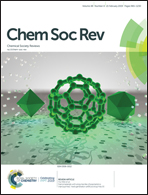Barium titanate at the nanoscale: controlled synthesis and dielectric and ferroelectric properties
Abstract
The current trend in the miniaturization of electronic devices has driven the investigation into many nanostructured materials. The ferroelectric material barium titanate (BaTiO3) has garnered considerable attention over the past decade owing to its excellent dielectric and ferroelectric properties. This has led to significant progress in synthetic techniques that yield high quality BaTiO3 nanocrystals (NCs) with well-defined morphologies (e.g., nanoparticles, nanorods, nanocubes and nanowires) and controlled crystal phases (e.g., cubic, tetragonal and multi-phase). The ability to produce nanoscale BaTiO3 with controlled properties enables theoretical and experimental studies on the intriguing yet complex dielectric properties of individual BaTiO3 NCs as well as BaTiO3/polymer nanocomposites. Compared with polymer-free individual BaTiO3 NCs, BaTiO3/polymer nanocomposites possess several advantages. The polymeric component enables simple solution processibility, high breakdown strength and light weight for device scalability. The BaTiO3 component enables a high dielectric constant. In this review, we highlight recent advances in the synthesis of high-quality BaTiO3 NCs via a variety of chemical approaches including organometallic, solvothermal/hydrothermal, templating, molten salt, and sol–gel methods. We also summarize the dielectric and ferroelectric properties of individual BaTiO3 NCs and devices based on BaTiO3 NCs via theoretical modeling and experimental piezoresponse force microscopy (PFM) studies. In addition, viable synthetic strategies for novel BaTiO3/polymer nanocomposites and their structure–composition–performance relationship are discussed. Lastly, a perspective on the future direction of nanostructured BaTiO3-based materials is presented.



 Please wait while we load your content...
Please wait while we load your content...
